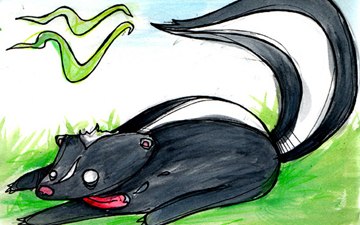The Striped Skunk, Mephitis mephitis, is an omnivorous mammal of the skunk family Mephitidae. Found over most of the North American continent north of Mexico, it is one of the best-known mammals in Canada and the United States.[3]
The Striped Skunk has a black body with a white stripe along each side of its body; the two stripes join into a broader white area at the nape. Its forehead has a narrow white stripe. About the size of a house cat, it weighs 2.5 to 14 pounds (1.2–6.3 kg) (Note that the average weight is 6-8 pounds (2.73kg-3.64 kg)) with a body length (excluding the tail) of 13 to 18 inches (33–46 cm). The bushy tail is 7 to 10 inches long (18–25 cm), and sometimes has a white tip.
The presence of a Striped Skunk is often first made apparent by its odor. It has well-developed anal scent glands (characteristic of all skunks) that can emit a highly unpleasant odor when the skunk feels threatened by another animal. The striped skunk may do a cartwheel while warning others.
(From Wikipedia, April 23, 2010)
– – –
The Striped Skunk is the most common skunk in North America, yet most of what we know about it comes from studies of captive individuals. Like all skunks, it has a superb defense system, the ability to spray a foul-smelling fluid from two glands near the base of its tail. Skunk musk is oily and difficult to remove. If sprayed in the eyes, it causes intense pain and temporary blindness. Skunk kittens can spray when they are only eight days old, long before they can aim, a skill they exhibit only after their eyes open at about 24 days. Skunks attempt to give a warning before they spray: both Hooded and Striped skunks stamp their front feet before turning around and spraying. Like all skunks, Striped Skunks are nocturnal and eat a variable diet, mostly of insects, but also including small mammals, carrion, and some vegetation.
(From EOL via Smithsonian, April 23, 2010)
– – –





